When you have
mutants you're better off that when you don't.
--Salvador E. Luria
A mutation is defined as any permanent change to the
genetic material. Mutation can be classified according
to several criteria. (There are also non-permanent
changes to the genetic material called epigenetic
changes, like methylation of DNA bases.)
- Origin of the Mutation: Mutations can
be either spontaneous or induced.
- Spontaneous Mutations: Mutations
occur naturally, but at a very low rate. We will
explore the chemical nature of some of these
spontaneous mutations later. The rate for
spontaneous mutations varies from organisms to
organism (10-4 to 10-8).
- Induced Mutations and Mutagens:
Mutations can be induced by various outside
factors, called mutagens.
- Chemical
Mutagens: Numerous chemicals
can alter DNA by reacting with it or creating
other molecules that react with DNA. Again, we
will study some examples later.
- Mutagenic
Radiation: Certain types of
radiation damage DNA.
- Ionizing Radiation:
Some radiation creates radicals or ion pairs
as it passes through tissue. These are very
reactive and can chemically modify DNA.
- X rays:
X rays are an example of ionizing radiation.
In 1927, H. J. Muller first showed that X
rays cause mutations.
- Others:
γ rays, β
and α particles, neutrons
are other examples of ionizing (therefore
mutagenic) radiation.
- Ultraviolet
Radiation:
Although some UV can cause ionization, it is
usually mutagenic due to its ability to create
covalent bonds between adjacent thymine bases
in DNA (thymine dimers, more later).
- Site of the
Mutation:
In multicellular organisms, mutations can be
classified as either germ-line mutations or somatic
mutations:
- Germ-Line Mutations: These are
mutations in gametes or cells destined to become
gametes. They can be passed along to future
generations.
- Somatic Mutations: There are
mutations in the somatic cells and cannot be
passed along.
- Carcinogenesis
and Mutagenesis: One class of
somatic mutations are those that turn a normal
gene into a cancer gene (oncogene). We will look
at this process briefly later in this course.
- Chromosome
Mutation vs. Gene Mutation:
Mutations can be classified as either chromosome
mutations or gene mutations.
- Chromosome Mutation: These
mutations change the chromosome number or
chromosome structure, but may not have any
detectable effect on the individual genes. Rather,
the dosage and/or locus of a gene is changed.
|
- Changes
in Chromosome Number: Many
chromosome mutations change the number of
chromosomes.
- Euploidy:
This is the addition or subtraction of a whole
haploid set (genome).
- Haploidy:
This is the 1n condition in an organism that
is normally 2n and is very rare.
|
|
- Polyploidy:
This is the gain of one or more genomes (3n,
4n, 5n, etc.). Polyploidy is common in many
plants and some lower animals. It may sexual
or asexual.
|
- Autopolyploidy:
Autopolyploidy involves the gaining of a
duplicate genomes from the same species.
This may occur spontaneously or may be
induced by microtubule blockers like
colchicine.
- Allopolyploidy:
Allopolyploidy is polyploidy by adding
genomes of different species.
|
- Aneuploidy
and Nondisjunction:
Aneuploidy is gaining or losing single (or
several) chromosomes. It is the main cause of
spontaneous abortions (35% of all) and is the
main cause of mental retardation. Aneuploidies
are also extremely common in cancer tumors
(causative or not?). Aneuploidy most commonly
occurs by a mistake of meiosis called
nondisjunction, which usually occurs at
anaphase I. This is the failure of homologous
chromosomes to segregate.
|
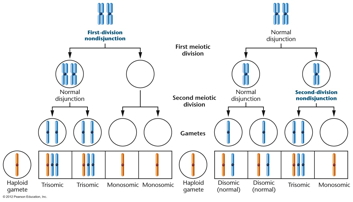 |
- Trisomy:
A trisomic individual has gained one
chromosome.
- Down
Syndrome:
Also called trisomy 21, this is a common
aneuploidy in humans. It usually occurs by
nondisjunction in oogenesis, with the rate
increasing with maternal age (average
frequency = 1/700; age 25 = 1/1400; age 35
= 1/350; age 40 = 1/100).
|
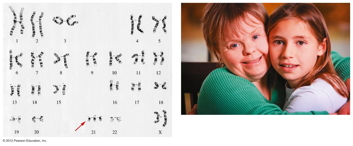
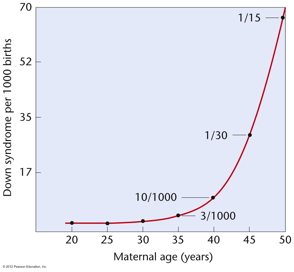
|
- Others:
There are other human trisomies that are
not as common as Down Syndrome, including
trisomy 18 (Edwards Syndrome) (1/8,000)
and trisomy 13 (1/20,000).
|
- Monosomy:
This is the loss of a single chromosome.
- Aneuploidy
of Sex Chromosomes:
These are common aneuploidies of sex
chromosomes in humans.
- Klinefelter
Syndrome:
In humans, an XXY male individual has this
syndrome (1/500). (Other rare Klinefelter
individuals may be XXXY, XXYY, XXXXY, or
even XXXXXY. They have more severe
symptoms.)
- Turner Syndrome:
In humans, an XO female has this syndrome
(1/2,500). Other Turner individuals may be
missing only a portion of the X
chromosome. (See NIH
info site)
- Others: XXX,
XYY and other aneuploidies are possible.
- A Hypothesis
for the Mechanisms of Aneuploidy:
Aneuploidy may produces a plethora of
effects but it has been postulated from work
originally in yeast (confirmed in mammals)
that aneuploidy creates stress on the
proteasome mechanism of cells. Proteasomes
are cellular complexes that include
proteases (protein-destroying enzymes).
These destroy unneeded or damaged
(misfolded) proteins. Thereby they help
regulate the relative concentration of
proteins, which is important in assembling
proteins with tertiary structure. Having an
extra chromosome increases the concentration
of proteins made by genes on that
chromosome. This put stress on the mechanism
that keeps the relative concentration of
proteins correct (proteasomes). In fact, it
appears that the higher the ploidy, the
lesser the effect of adding a single
chromosome. (A 1n yeast cell with and extra
chromosome is more defective than a 2n cell
with an extra chromosome, presumably because
the relative concentration of proteins is
further off in the 1n cell.) Targeting cells
with aneuploidies with drugs presents a
novel way of attaching cancer cells, since
aneuploidy is common in tumors. (Amon, GSA
2012)
|
- Changes
in Chromosome Structure:
Chromosomal segment may change their copy number
or location.
- Duplication:
If a segment is duplicated, it can be in one
of three configurations.
- Tandem
Duplications:
These have the duplicated segment in the
original order and next to it.
|
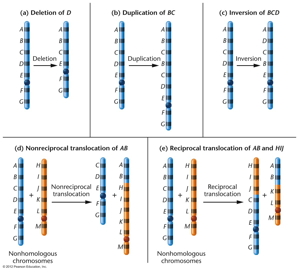 |
- Unequal
Crossing Over:
This mistake of meiosis I can cause both
tandem duplications and deletions.
(Duplications and deletions may occur by
other mechanisms also.)
- Homologous
Unequal Crossing
Over:
This is a secondary event that occurs as
a result of the presence of a previous
tandem duplication, as illustrated by
the Bar
mutation in Drosophila.
- Nonhomologous
Unequal Crossing
Over:
This is the original event that creates
a tandem duplication and deletion.
|
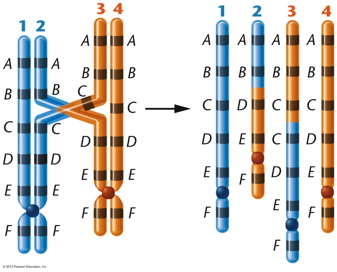

|
- Palindromes:
This is a repeat that is in reverse order
compared to the original segment.
- Displace
Duplications:
This is a duplication in which the
duplicated segment is not adjacent to the
original segment.
- Human
Duplications:
- β-Thalassemia:
This
genetic disease most likely arose by
homologous unequal crossing over between
the δ and β globin genes on chromosome 11,
resulting in a δ/β fusion gene and an
altered hemoglobin called Lepore
hemoglobin.
- Huntington Disease: This is an autosomal
dominant trait (the HTT gene on
chromosome 4) with incomplete
penetrance that is due to a
trinucleotide repeat (CAG)n, encoding
multiple glutamines in the huntingtin (the
Huntington disease protein). The normal
number of repeats is between 9 and 36.
Persons with 36-39 repeats show the reduce
penetrance describe in the Mendel Revisited
outline (McNeil SM et al. 1997, Hum Mol
Genet. 6:775). Juvenile-onset Huntington
disease (onset before age 20) is usually
inherited from the father and affected
individuals have 60 or more repeats.
However, "a substantial proportion of the
variance in age of onset in Huntington
disease is due either to variation in
genes other than HTT or in the
environment" (Wexler et al. 2004. Proc
Natl Acad Sci USA 101:3498). The function
of huntingtin in the cell is unknown..."
as of 2012
(http://www.ncbi.nlm.nih.gov/pubmed/22482451),
but it is known to have its effect on
brain cells.
- Deletions:
Like tandem duplications, deletion (also
called deficiencies) can also be caused by
unequal crossing over (and other mechanisms).
(Cri-du-chat,
first documented human deletion). Duplications
and deletions may be referred to as copy
number variants (CNVs).
|
- Inversions:
Inversions involve reversing the orientation
of a segment of a chromosome. Inversion may be
paracentric or pericentric. Inversion
heterozygotes have problems making functional
gametes due to crossing over in the inverted
segment.
|
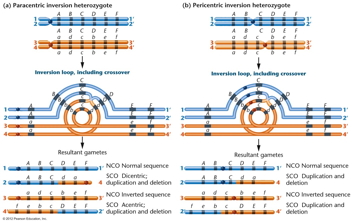
|
- Translocations: Translocations
move a segment to a non-homologous chromosome.
Just as with inversion heterozygotes,
reciprocal translocation heterozygotes have
reduced fertility.
|
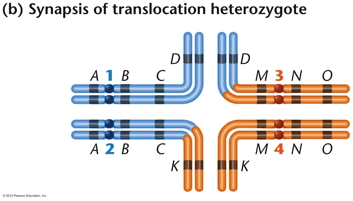 |
- Robertsonian
Translocation
(Robertsonian
Fusion): A
nonhomologous exchange between two
acrocentric or telocentric chromosomes can
result in a fused (metacentric) chromosome.
(Reference:
mechanisms may result in two closely
adjacent centromeres and one acentric
fragment, rather than as illustrated to the
right. Here
is a more recent article proposing how
Robertsonian translocations between
two telocentric chromosomes may occur.)
|
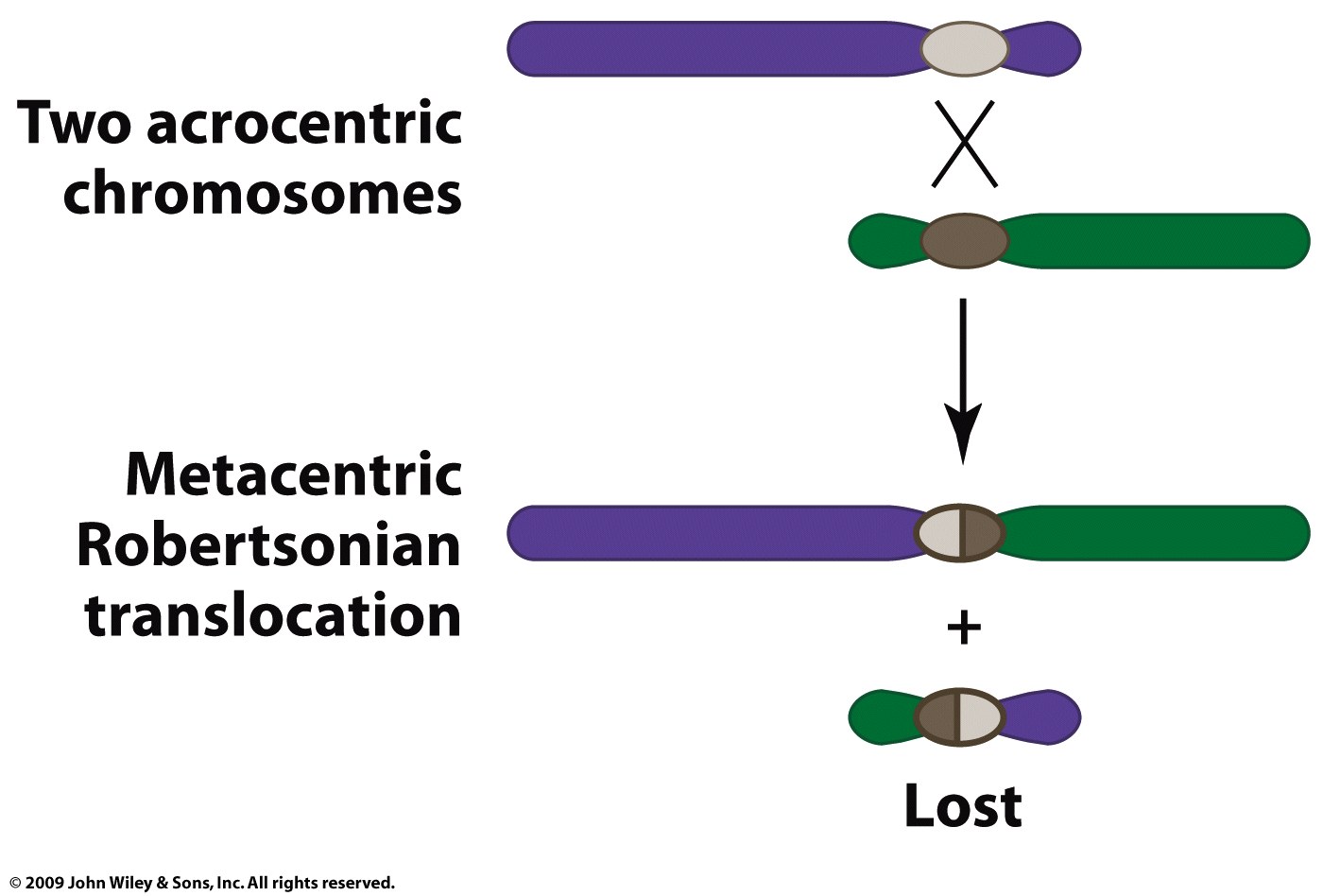 |
- Karyotyping
and Chromosome
Mutations:
Karyotyping
makes it possible to detect chromosome
mutations. The human karyotype divides the
chromosome into groups A, B, C, D, E, F, G, and
sex chromosomes. (Arrange in size order, large
to small; A group (3 pairs) = metacentric and
submetacentric, B (2 pairs) group =
submetacentric, C group (7 pairs) = metacentric,
D group (3 pairs) = acrocentric, E group (3
pairs) = metacentric, F group (2 pairs), G group
(2 pairs) = acrocentric, X chromosome = resemble
a C group chromosome, Y chromosome = resembles a
G group chromosome.)
- Gene Mutations: (Next outline)
|
|
Things I Learned at
the Movies:
Radiation causes
interesting mutations — not to your future children,
but to you, right then and there.
|




